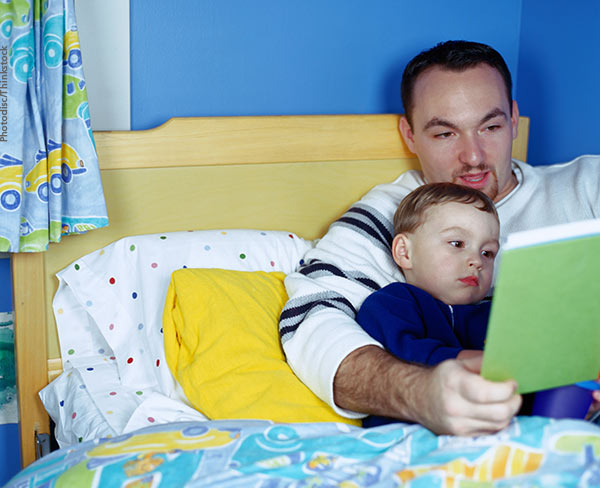Go to Bed Happy, Wake Up Happy
Developing a harmonious and rewarding bedtime routine results in a happier family — day and night.
One of the most essential ingredients to happiness and health, especially for developing children, is getting enough sleep each night. In many families, bedtime becomes a nightly ritual of arguing and turmoil, but you can prevent or reverse this while helping ensure your child(ren) receive a good night’s sleep.
The Secret to Nightly Harmony is to develop a nightly routine that helps everyone in the family wind down, relax, and enjoy each other.
Here’s an example of a relaxing nighttime routine:
- First Years: One parent reads to the child while the other parent or partner is free to engage in non-bedtime pursuits. Then the other parent puts the child to bed with a back rub or song or story. A bath might also be part of the routine. Parents can trade roles each night.
- Elementary Years: Parents and child read together before alternating the task of putting the child to bed with a back rub and story. Sometimes, it might just require some quiet time and talk between parent and child.
- Middle School: Most middle school kids can handle a more flexible routine, but it remains important that the family spend some relaxing time together before lights out (e.g., reading time, a game, and/or a back rub and/or being tucked in).
Essential TIPS:
- Once the routine begins, stay off electronic devices during your time with your child.
- Once the routine begins, do not bring up problems from the day or things that need to happen tomorrow. It’s time for sleep, not stressing kids out with what they did wrong that day or what responsibilities are coming up.
- Strategically place “brush teeth” at the front of the routine for kids who will more gladly do it with fun stuff they are looking forward to or at the end of the routine for kids who will more gladly do it after they have relaxed with their family.
What makes a regular and relaxing routine work so well?
- Bonding. Instead of a time of stress (we have to get to sleep!) and commands (go brush your teeth!), a relaxing routine creates a space to develop mutual understanding and respect that builds greater bonds.
- Consistency(routine) and boundaries (bedtime, no devices, etc.). The predictability of knowing what will happen (especially when it’s positive and helpful) provides children with a sense of “safety and security,” which are essential for relaxing and sleeping well.
- Happy parents, Happy Kids. Parents gain the same benefits they provide their child: less stress, more bonding, more predictability, more rest…
Troubleshooting
- If noise is bothering your child(ren): Beyond bringing the noise levels down in the household, you can get a noise filtering device (search amazon.com “sound machine” or “sound conditioner”), which will create a soothing sound of moving air while filtering out intrusive noises from the household.
- If you child has difficulty relaxing: Make sure the last ritual is a relaxing one, like a hot bath and/or a back rub. During the bedtime ritual, don’t bring up problems from the day or things that have to be done the next day, as these create unnecessary thinking. Try using Indigo Dreams CDs/MP3s (amazon.com) for their relaxing music as well as stories that teach relaxation techniques and ways to cope with anger, worry, and other issues that can get in the way of sleep.
- Multiple children: Divide and conquer (e.g., Tonight, Dad tucks in one or more, while Mom tucks in the others.) Then alternate, as possible.
- If Mom or Dad is not home: A phone call to say good night is a nice touch. The remaining parent should try not to alter the routine more than necessary.
Kirk Stuepfert, MSW, is a child and family therapist at Parents Place on the Peninsula.



